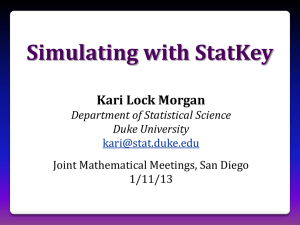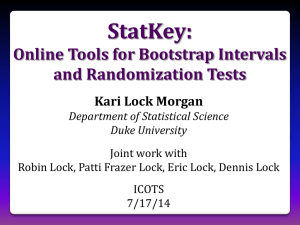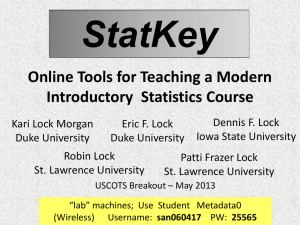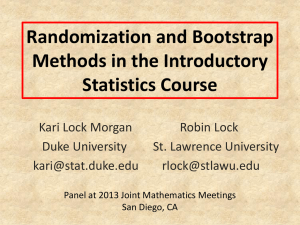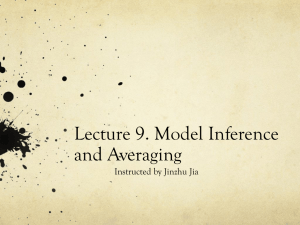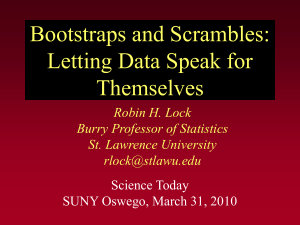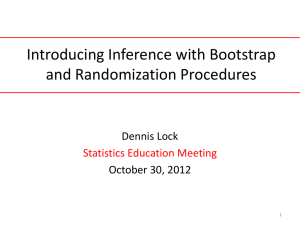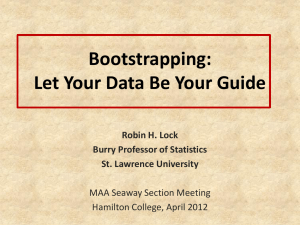- Unlocking the Power of Data
advertisement
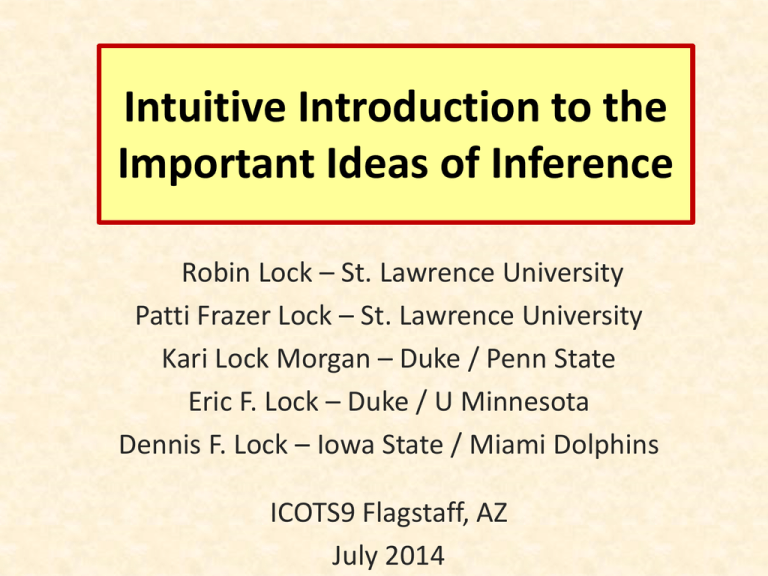
Intuitive Introduction to the Important Ideas of Inference Robin Lock – St. Lawrence University Patti Frazer Lock – St. Lawrence University Kari Lock Morgan – Duke / Penn State Eric F. Lock – Duke / U Minnesota Dennis F. Lock – Iowa State / Miami Dolphins ICOTS9 Flagstaff, AZ July 2014 The Lock5 Team Robin & Patti St. Lawrence Dennis Iowa State/ Miami Dolphins Kari Duke / Penn State Eric Duke / UMinn Outline • Estimating with confidence (Bootstrap) • Understanding p-values (Randomization) • Implementation • Organization of simulation methods? • Role for distribution-based methods? • Textbook/software support? U.S. Common Core Standards (Grades 9-12) Statistics: Making Inferences & Justifying Conclusions HSS-IC.A.1 Understand statistics as a process for making inferences about population parameters based on a random sample from that population. HSS-IC.A.2 Decide if a specified model is consistent with results from a given data-generating process, e.g., using simulation. HSS-IC.B.3 Recognize the purposes of and differences among sample surveys, experiments, and observational studies; explain how randomization relates to each. HSS-IC.B.4 Use data from a sample survey to estimate a population mean or proportion; develop a margin of error through the use of simulation models for random sampling. HSS-IC.B.5 Use data from a randomized experiment to compare two treatments; use simulations to decide if differences between parameters are significant. Example #1: Body Temperatures Sample of body temperatures (in oF) for n=50 students (Shoemaker, JSE, 1996) 𝑛 = 50 𝑥 = 98.26 𝑠 = 0.765 Goal: Find an interval that is likely to contain the mean body temperature for all students Key concept: How much should we expect the sample means to vary just by random chance? Can we estimate this using ONLY data from this sample? Brad Efron Stanford University Bootstrapping “Let your data be your guide.” Basic Idea: Create simulated samples, based only the original sample data, to approximate the sampling distribution and standard error of the statistic. Brad Efron Stanford University Bootstrapping “Let your data be your guide.” To create a bootstrap distribution: • Assume the “population” is many, many copies of the original sample. • Simulate many “new” samples from the population by sampling with replacement from the original sample. • Compute the sample statistic for each bootstrap sample. Finding a Bootstrap Sample Original Sample (n=6) A simulated “population” to sample from Bootstrap Sample (sample with replacement from the original sample) Bootstrap Sample Original Sample 97.6 98.9 98.4 96.9 97.7 98.2 97.4 99.3 98.5 96.4 99.4 99.0 98.8 99.5 98.3 98.0 97.5 98.2 98.6 98.0 99.0 98.8 97.8 96.8 97.8 98.9 98.8 97.6 97.4 100.8 97.8 97.2 98.2 98.0 98.1 97.7 98.8 98.4 97.7 98.2 𝑥 = 98.26 98.0 99.0 98.4 97.9 98.3 98.2 98.4 99.0 98.7 98.7 99.3 98.2 99.0 99.0 97.2 100.8 98.0 98.9 98.1 98.4 96.4 98.7 98.2 97.7 96.4 99.0 97.6 97.7 98.6 98.6 98.6 99.3 99.0 96.8 98.5 96.8 97.6 98.9 98.3 99.4 99.0 99.5 98.8 97.2 98.9 98.2 98.3 98.2 98.4 98.8 98.3 98.2 96.8 97.6 98.4 100.8 97.7 99.0 97.4 99.0 𝑥 = 98.35 98.8 97.5 98.7 96.8 98.4 98.3 98.7 98.0 97.8 99.0 99.0 96.9 98.8 98.0 98.2 98.0 98.2 98.7 97.8 97.6 100.8 96.8 97.7 96.9 100.8 98.8 98.2 97.7 99.3 99.3 98.4 98.2 98.4 97.8 98.4 97.4 98.7 97.7 98.7 97.8 97.6 97.8 97.9 98.2 98.3 97.8 98.7 97.5 97.5 98.7 Repeat 1,000’s of times! 𝑥 = 98.22 Original Sample Sample Statistic Bootstrap Sample Bootstrap Statistic Bootstrap Sample Bootstrap Statistic ● ● ● Many times ● ● ● StatKey We need technology! Bootstrap Sample Bootstrap Statistic Bootstrap Distribution StatKey www.lock5stat.com/statkey Freely available web apps with no login required Runs in (almost) any browser (incl. smartphones/tablets) Google Chrome App available (no internet needed) Standalone or supplement to existing technology * ICOTS talk on StatKey: Session 9B, Thursday 7/17 at 10:55 Bootstrap Distribution for Body Temp Means How do we get a CI from the bootstrap distribution? Method #1: Standard Error • Find the standard error (SE) as the standard deviation of the bootstrap statistics • Find an interval with 𝑂𝑟𝑖𝑔𝑖𝑛𝑎𝑙 𝑆𝑡𝑎𝑡𝑖𝑠𝑡𝑖𝑐 ± 2 ⋅ 𝑆𝐸 Bootstrap Distribution for Body Temp Means Standard Error 98.26 ± 2 ∙ 0.108 = (98.04, 98.48) How do we get a CI from the bootstrap distribution? Method #1: Standard Error • Find the standard error (SE) as the standard deviation of the bootstrap statistics • Find an interval with 𝑂𝑟𝑖𝑔𝑖𝑛𝑎𝑙 𝑆𝑡𝑎𝑡𝑖𝑠𝑡𝑖𝑐 ± 2 ⋅ 𝑆𝐸 Method #2: Percentile Interval • For a 95% interval, find the endpoints that cut off 2.5% of the bootstrap means from each tail, leaving 95% in the middle 95% Confidence Interval Chop 2.5% in each tail Keep 95% in middle Chop 2.5% in each tail We are 95% sure that the mean body temperature for all students is between 98.04oF and 98.49oF Bootstrap Confidence Intervals Version 1 (Statistic 2 SE): Great preparation for moving to traditional methods Version 2 (Percentiles): Great at building understanding of confidence intervals Same process works for different parameters Why does the bootstrap work? Sampling Distribution Population BUT, in practice we don’t see the “tree” or all of the “seeds” – we only have ONE seed µ Bootstrap Distribution What can we do with just one seed? Estimate the distribution and variability (SE) of 𝑥’s from the bootstraps Bootstrap “Population” Grow a NEW tree! 𝑥 µ Chris Wild: Use the bootstrap errors that we CAN see to estimate the sampling errors that we CAN’T see. Golden Rule of Bootstraps The bootstrap statistics are to the original statistic as the original statistic is to the population parameter. Example #2: Sleep vs. Caffeine • Volunteers shown a list of 25 words. • Before recall: Randomly assign to either Sleep (1.5 hour nap) OR Caffeine (and awake) • Measure number of words recalled. n Sleep Caffeine mean stdev 12 15.25 3.31 12 12.25 3.55 Does this provide convincing evidence that the mean number of words recalled after sleep is higher than after caffeine or could this difference be just due to random chance? Mednick, Cai, Kannady, and Drummond, “Comparing the Benefits of Caffeine, Naps and Palceboon Verbal, Motor and Perceptual Memory” Behavioural Brain Research (2008) Example #2: Sleep vs. Caffeine H0: μS = μC Ha: μS > μC µ = mean number of words recalled Based on the sample data: 𝑥𝑆 −𝑥𝐶 = 15.25 − 12.25 = 3.0 Is this a “significant” difference? How do we measure “significance”? ... KEY IDEA P-value: The proportion of samples, when H0 is true, that would give results as (or more) extreme as the original sample. Say what???? Traditional Inference 1. Check conditions 2. Which formula? 𝑡= 𝑥𝑆 − 𝑥𝐶 𝑠𝑆2 𝑠𝐶2 + 𝑛𝑆 𝑛𝐶 5. Which theoretical distribution? 6. df? 7. Find p-value 8. Interpret a decision 3. Calculate numbers and plug into formula 𝑡= 15.25 − 12.25 2 3.312 3.55 + 12 12 4. Chug with calculator 𝑡 = 2.14 0.025 < p-value < 0.050 Randomization Approach • Create a randomization distribution by simulating many samples from the original data, assuming H0 is true, and calculating the sample statistic for each new sample. • Estimate p-value directly as the proportion of these randomization statistics that exceed the original sample statistic. Randomization Approach Number of words recalled Sleep 9 11 13 14 14 15 16 17 17 18 18 21 Caffeine 6 7 10 10 12 12 13 14 14 15 16 18 To simulate samples under H0 (no difference): • Re-randomize the values into Sleep & Caffeine groups 𝑥𝑠 = 15.25 Original Sample 𝑥𝑐 = 12.25 𝑥𝑠 − 𝑥𝑐 = 3.0 Randomization Approach Number of words recalled Sleep 9 11 13 14 14 15 16 17 17 18 18 21 Caffeine 6 7 9 10 10 11 12 12 13 13 14 14 14 14 15 15 16 16 17 17 18 18 18 21 6 7 10 10 12 12 13 14 14 15 16 18 To simulate samples under H0 (no difference): • Re-randomize the values into Sleep & Caffeine groups 𝑥𝑠 = 15.25 𝑥𝑐 = 19.22 𝑥𝑠 − 𝑥𝑐 = 3.0 Randomization Approach Number of words recalled Sleep Caffeine 6 7 9 10 10 11 11 12 12 12 13 12 13 14 13 14 14 13 14 15 14 15 16 14 16 17 14 18 17 14 18 18 15 21 15 16 16 17 17 18 18 18 21 StatKey To simulate samples under H0 (no difference): • Re-randomize the values into Sleep & Caffeine groups • Compute 𝑥𝑠 − 𝑥𝑐 Repeat this process 1000’s of times to see how “unusual” is the original difference of 3.0. 𝑥𝑠 = 13.50 𝑥𝑐 = 14.00 𝑥𝑠 − 𝑥𝑐 = −0.50 p-value = proportion of samples, when H0 is true, that are as (or more) extreme as the original sample. p-value Implementation Issues • What about traditional (distribution-based) methods? • Intervals first or tests? • One Crank or Two? • Textbooks? • Technology/Software? How does everything fit together? • We use simulation methods to build understanding of the key ideas of inference. • We then cover traditional normal and t-based procedures as “short-cut formulas”. • Students continue to see all the standard methods but with a deeper understanding of the meaning. Intro Stat – Revise the Topics • • •• • • • • Descriptive Statistics – one and two samples Normal distributions Bootstrap confidence intervals Data production (samples/experiments) Randomization-based hypothesis tests Sampling distributions (mean/proportion) Normal distributions Confidence intervals (means/proportions) • Hypothesis tests (means/proportions) • ANOVA for several means, Inference for regression, Chi-square tests Transition to Traditional Inference Confidence Interval: 𝑆𝑎𝑚𝑝𝑙𝑒 𝑆𝑡𝑎𝑡𝑖𝑠𝑡𝑖𝑐 ± 𝑧 ∗ ∙ 𝑆𝐸 (or 𝑡 ∗ ) Hypothesis Test: 𝑆𝑎𝑚𝑝𝑙𝑒 𝑆𝑡𝑎𝑡𝑖𝑠𝑖𝑐 − 𝑁𝑢𝑙𝑙 𝑃𝑎𝑟𝑎𝑚𝑒𝑡𝑒𝑟 𝑧= 𝑆𝐸 Need to know: • Formula for SE • Conditions to use a “traditional” distribution One Crank or Two? John Holcomb (ICOTS8) Crank #1: Reallocation Example: Scramble the sleep/caffeine labels in the word memory experiment Crank #2: Resample Example: Sample body temps with replacement to get bootstrap samples Example: Suppose we sampled 12 “nappers” and 12 “caffeine” drinkers to compare word memory... Textbooks? Statistical Reasoning in Sports (WH Freeman) Tabor & Franklin Statistics: Unlocking the Power of Data (Wiley) Lock, Lock, Lock Morgan, Lock, Lock Statistical Thinking: A Simulation Approach to Modeling Uncertainty (Catalyst Press) Zieffler & Catalysts for Change Introduction to Statistical Investigations (Wiley) Tintle, Chance, Cobb, Rossman, Roy, Swanson and VanderStoep Software? StatKey www.lock5stat.com/statkey Rossman/Chance Applets www.rossmanchance.com VIT: Visual Inference Tools Chris Wild www.stat.auckland.ac.nz/~wild/VIT/ Mosaic (R package) Kaplan, Horton, Pruim http://mosaic-web.org/r-packages/ Fathom/TinkerPlots Finzer, Konold Thanks for Listening! Questions? Robin – rlock@stlawu.edu Patti – plock@stlawu.edu Kari – klm47@psu.edu Eric – Eric.F.Lock@gmail.com Dennis – DLock@dolphins.com All – lock5stat@gmail.com
